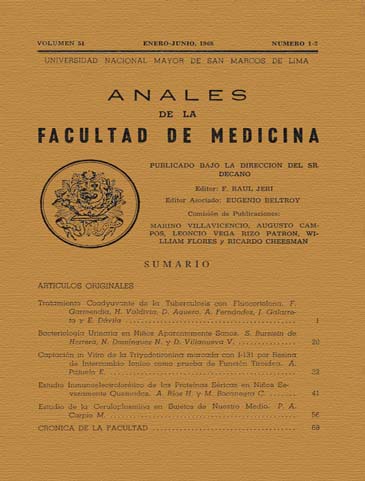Immunoelectrophoretic study of serum proteins in severely burned children
DOI:
https://doi.org/10.15381/anales.v51i1-2.5275Abstract
In the past 20 years there have been considerable advances in the treatment of patients with severe burns (more than 10% of body surface area), mainly in regard to shock therapy (1, 11, 14. 16 , 21, 22), which have resulted in a significant reduction in early mortality (within the first 60 hours after trauma). This improvement is due to a better understanding of the pathophysiological mechanisms of traumatic shock, allowing new, especially referable to the proper use of balanced solutions alone or supplemented with sodium chloride plasma therapeutic approaches, which allowed decreasing the mortality in this early phase and prolonged the survival of severely burned patients.Downloads
Published
1968-06-17
Issue
Section
Trabajos originales
License
Copyright (c) 1968 Alex Ríos Huerta, Manuel Bocanegra Carrasco

This work is licensed under a Creative Commons Attribution-NonCommercial-ShareAlike 4.0 International License.
Those authors who have publications with this magazine accept the following terms:
- Authors will retain their copyrights and guarantee the journal the right of first publication of their work, which will be simultaneously subject to Creative Commons Attribution License that allows third parties to share the work as long as its author and its first publication this magazine are indicated.
- Authors may adopt other non-exclusive licensing agreements for the distribution of the version of the published work (eg, deposit it in an institutional electronic file or publish it in a monographic volume) provided that the initial publication in this magazine is indicated.
- Authors are allowed and recommended to disseminate their work over the Internet (eg: in institutional telematic archives or on their website) before and during the submission process, which It can produce interesting exchanges and increase quotes from the published work. (See El efecto del acceso abierto ).
How to Cite
1.
Ríos Huerta A, Bocanegra Carrasco M. Immunoelectrophoretic study of serum proteins in severely burned children. An Fac med [Internet]. 1968 Jun. 17 [cited 2024 Aug. 16];51(1-2):41-55. Available from: https://revistasinvestigacion.unmsm.edu.pe/index.php/anales/article/view/5275















